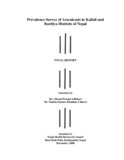Please use this identifier to cite or link to this item:
https://hdl.handle.net/20.500.14356/329Full metadata record
| DC Field | Value | Language |
|---|---|---|
| dc.contributor.author | Adhikari, Shyam Prasad | |
| dc.contributor.author | Chhetri, Madhu Kumar Khadaka | |
| dc.date.accessioned | 2012-12-31T22:21:21Z | |
| dc.date.accessioned | 2022-11-08T10:14:22Z | - |
| dc.date.available | 2012-12-31T22:21:21Z | |
| dc.date.available | 2022-11-08T10:14:22Z | - |
| dc.date.issued | 2008 | |
| dc.identifier.uri | http://103.69.126.140:8080/handle/20.500.14356/329 | - |
| dc.description.abstract | EXECUTIVE SUMMARY Arsenic has been known for years to be a very poisonous element and arsenicosis is one of the burning issues in Nepal today. In lowlands of Nepal, the Arsenic concentration in the pumped "drinking" water have shown to be of such a magnitude that the population in these areas, by switching from surface water to groundwater, can be said to have come from the frying-pan into the fire. Kailali and Bardiya districts are most affected districts of western Terai where majority of residence are from Tharu community and have little or no knowledge on arsenic, its poisoning and possible mitigation measures. Unfortunately, research activities on prevalence of arsenicosis and awareness raising and mitigation activities are lacking in these areas. Hence, it was imperative to explore current status on prevalence of arsenicosis to undertake relevant actions to minimize, if possible alleviate, arsenicosis impacts. This study, therefore, was conducted to find outthe prevalence of arsenicosis and its association with other socio-economic factors among the risk population in the different communities of Thapapur and Sadepani VDCs of Kailali district and Mohamadpur and Jamuni VDCs of Bardiya district. This comprehensive project adopted questionnaire survey and examination of skin laison by the experts using WHO flow chart algorithm as its major study methods. Key findings of the study illustrate that (a) the impact of arsenic problem in study area is significant with the overall prevalence of arsenicosis as 2.12% in Kailali district and 2.66% in Bardiya district; (b) Gender has apparent effect on the prevalence of arsenicosis indicating much higher symptoms among males than in females; (c)The people from older age group are affected significantly to a far greater extent than people from younger age group and a virtually negligible prevalence among those less than 15 years old; and (d) The people from poor socioeconomic group are affected significantly to a far greater extent than people from non-poor socioeconomic group. Since major causes of arsenicosis problem are poverty, illiteracy and lack of mitigating and monitoring measures, arsenic mitigation programmes should target the arsenic exposed malnourished poor population as a priority. Moreover, it is hoped that the result of this project will assist the concern authorities of Government of Nepal in formulating effective management plans for the mitigation of arsenicosis. | en_US |
| dc.description.sponsorship | Nepal Health Research Council | en_US |
| dc.language.iso | en_US | en_US |
| dc.publisher | Nepal Health Research Council | en_US |
| dc.subject | Arsenicosis | en_US |
| dc.title | Prevalence Survey of Arsenicosis in Kailali and Bardiya Districts of Nepal | en_US |
| dc.type | Technical Report | en_US |
| Appears in Collections: | Post Graduate Grant (PG) Reports | |
Items in DSpace are protected by copyright, with all rights reserved, unless otherwise indicated.

